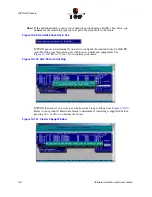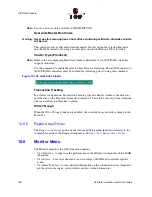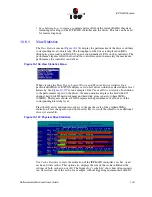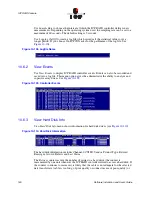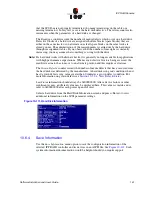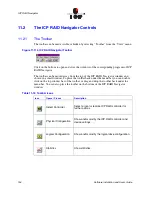
Software Installation and User’s Guide
141
ICP RAID Console
10.5.4.3
Notes on the Configuration of RAID 0, 1, 4, 5 and 10 Arrays Drives
Use logical drives of the type
disk to build an array drive.
RAID array drives can be configured with logical drives of the type
chain
also, but
security should be taken into consideration. For regular RAID array drives, type
disk
logical drives are used.
Logical drives of an array drive should have the same storage capacity.
To avoid wasting valuable storage capacity, use only logical drives that have the same
storage capacity as the logical drive being replaced on that array.
A hot fix drive provides the most security.
One of the reasons RAID array drives are used, lies with the data
r
edundancy they
provide, that is, the data security you have in the event of a hard disk failure. For the
purpose of the following considerations, we define the term
time without redundancy
(
TWR) as the time it takes to replace a failed hard drive (assuming there is no hot fix drive
installed in the system). The time without redundancy should be kept as short as possible,
not including the time needed to set up the array drive (state
build
).
Assume that one of the hard disks of a RAID 5 array drive has failed. The array drive is
without redundancy. TWR begins. Any superfluous prolongation of the TWR (because
you have to get a replacement hard disk, or because no one checked the file server)
increases the risk of data loss should a second hard disk fail. Therefore, new redundancy
should be created as soon as possible and in an entirely automated manner. Integrate a hot
fix drive as an immediately available and auto-replacing hard disk to keep the TWR as
short as possible. Only a hot fix drive can ensure optimal array drive security and constant
data availability. Of course a hot fix drive is not mandatory. If you control the array drive
at regular intervals and immediately replace a defective hard disk (by shutting down the
system or using a hot fix), you can minimize the risk of data loss.
10.5.5
Configure Host Drives
The
Configure Host Drives
option (
Figure 10-104
) allows you to configure host drives
(level of hierarchy 4). These are the drives the host computer is aware of. Host drives can
consist of a single hard disk, or of many hard disks built to create a RAID 5 array drive.
This menu option is similar to the
Configure Host Drives
option
in Express Setup (see
Section 10.4.1
). Unlike Express Setup, Advanced Setup allows the user to select a stripe
size while Express Setup defaults the stripe size to 128KB. Also, Advanced Setup has the
Split Host Drive
,
Merge Host Drives
, and
Partition Drive
menu options.
The additional capacity resulting from an online capacity expansion is shown as another
host drive. If you expand the capacity of the array drive a second time, there would be
three host drives belonging to the same array drive. Since there is currently no operating
system which supports “growing hard disks”, this expansion method is the only safe way
to introduce new capacity.
Содержание 2074700-R - ICP Vortex GDT8514RZ RAID Controller
Страница 1: ...Preliminary ICP RAID Software Software Installation and User s Guide Version 1 2 7 June 2003 ...
Страница 23: ...Software Installation and User s Guide 23 Introduction ...
Страница 68: ...68 Software Installation and User s Guide Installing Linux ...
Страница 92: ...92 Software Installation and User s Guide Installing Berkeley UNIX FreeBSD ...
Страница 214: ...214 Software Installation and User s Guide Fibre Channel Features ...


















